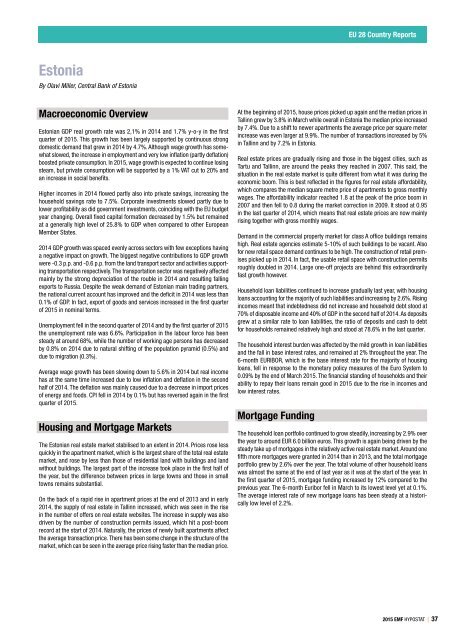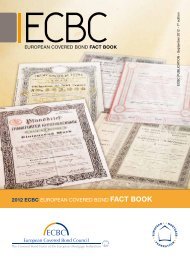Hypostat 2015
On 30 September 2015, the EMF-ECBC published Hypostat 2015 , which is its main statistical report, encompassing data on recent developments in housing and mortgage markets in the EU28 and beyond. Hypostat is the result of a collaborative effort by the European Mortgage Federation’s national delegations and external experts. The publication covers 33 countries – i.e. the EU28 plus Iceland, Norway, Russia, Turkey and the United States.
On 30 September 2015, the EMF-ECBC published Hypostat 2015 , which is its main statistical report, encompassing data on recent developments in housing and mortgage markets in the EU28 and beyond. Hypostat is the result of a collaborative effort by the European Mortgage Federation’s national delegations and external experts.
The publication covers 33 countries – i.e. the EU28 plus Iceland, Norway, Russia, Turkey and the United States.
Create successful ePaper yourself
Turn your PDF publications into a flip-book with our unique Google optimized e-Paper software.
EU 28 Country Reports<br />
Estonia<br />
By Olavi Miller, Central Bank of Estonia<br />
Macroeconomic Overview<br />
Estonian GDP real growth rate was 2,1% in 2014 and 1.7% y-o-y in the first<br />
quarter of <strong>2015</strong>. This growth has been largely supported by continuous strong<br />
domestic demand that grew in 2014 by 4.7%. Although wage growth has somewhat<br />
slowed, the increase in employment and very low inflation (partly deflation)<br />
boosted private consumption. In <strong>2015</strong>, wage growth is expected to continue losing<br />
steam, but private consumption will be supported by a 1% VAT cut to 20% and<br />
an increase in social benefits.<br />
Higher incomes in 2014 flowed partly also into private savings, increasing the<br />
household savings rate to 7.5%. Corporate investments slowed partly due to<br />
lower profitability as did government investments, coinciding with the EU budget<br />
year changing. Overall fixed capital formation decreased by 1.5% but remained<br />
at a generally high level of 25.8% to GDP when compared to other European<br />
Member States.<br />
2014 GDP growth was spaced evenly across sectors with few exceptions having<br />
a negative impact on growth. The biggest negative contributions to GDP growth<br />
were -0.3 p.p. and -0.6 p.p. from the land transport sector and activities supporting<br />
transportation respectively. The transportation sector was negatively affected<br />
mainly by the strong depreciation of the rouble in 2014 and resulting falling<br />
exports to Russia. Despite the weak demand of Estonian main trading partners,<br />
the national current account has improved and the deficit in 2014 was less than<br />
0.1% of GDP. In fact, export of goods and services increased in the first quarter<br />
of <strong>2015</strong> in nominal terms.<br />
Unemployment fell in the second quarter of 2014 and by the first quarter of <strong>2015</strong><br />
the unemployment rate was 6.6%. Participation in the labour force has been<br />
steady at around 68%, while the number of working age persons has decreased<br />
by 0.8% on 2014 due to natural shifting of the population pyramid (0.5%) and<br />
due to migration (0.3%).<br />
Average wage growth has been slowing down to 5.6% in 2014 but real income<br />
has at the same time increased due to low inflation and deflation in the second<br />
half of 2014. The deflation was mainly caused due to a decrease in import prices<br />
of energy and foods. CPI fell in 2014 by 0.1% but has reversed again in the first<br />
quarter of <strong>2015</strong>.<br />
Housing and Mortgage Markets<br />
The Estonian real estate market stabilised to an extent in 2014. Prices rose less<br />
quickly in the apartment market, which is the largest share of the total real estate<br />
market, and rose by less than those of residential land with buildings and land<br />
without buildings. The largest part of the increase took place in the first half of<br />
the year, but the difference between prices in large towns and those in small<br />
towns remains substantial.<br />
On the back of a rapid rise in apartment prices at the end of 2013 and in early<br />
2014, the supply of real estate in Tallinn increased, which was seen in the rise<br />
in the number of offers on real estate websites. The increase in supply was also<br />
driven by the number of construction permits issued, which hit a post-boom<br />
record at the start of 2014. Naturally, the prices of newly built apartments affect<br />
the average transaction price. There has been some change in the structure of the<br />
market, which can be seen in the average price rising faster than the median price.<br />
At the beginning of <strong>2015</strong>, house prices picked up again and the median prices in<br />
Tallinn grew by 3.8% in March while overall in Estonia the median price increased<br />
by 7.4%. Due to a shift to newer apartments the average price per square meter<br />
increase was even larger at 9.9%. The number of transactions increased by 5%<br />
in Tallinn and by 7.2% in Estonia.<br />
Real estate prices are gradually rising and those in the biggest cities, such as<br />
Tartu and Tallinn, are around the peaks they reached in 2007. This said, the<br />
situation in the real estate market is quite different from what it was during the<br />
economic boom. This is best reflected in the figures for real estate affordability,<br />
which compares the median square metre price of apartments to gross monthly<br />
wages. The affordability indicator reached 1.8 at the peak of the price boom in<br />
2007 and then fell to 0.8 during the market correction in 2009. It stood at 0.95<br />
in the last quarter of 2014, which means that real estate prices are now mainly<br />
rising together with gross monthly wages.<br />
Demand in the commercial property market for class A office buildings remains<br />
high. Real estate agencies estimate 5-10% of such buildings to be vacant. Also<br />
for new retail space demand continues to be high. The construction of retail premises<br />
picked up in 2014. In fact, the usable retail space with construction permits<br />
roughly doubled in 2014. Large one-off projects are behind this extraordinarily<br />
fast growth however.<br />
Household loan liabilities continued to increase gradually last year, with housing<br />
loans accounting for the majority of such liabilities and increasing by 2.6%. Rising<br />
incomes meant that indebtedness did not increase and household debt stood at<br />
70% of disposable income and 40% of GDP in the second half of 2014. As deposits<br />
grew at a similar rate to loan liabilities, the ratio of deposits and cash to debt<br />
for households remained relatively high and stood at 78.6% in the last quarter.<br />
The household interest burden was affected by the mild growth in loan liabilities<br />
and the fall in base interest rates, and remained at 2% throughout the year. The<br />
6-month EURIBOR, which is the base interest rate for the majority of housing<br />
loans, fell in response to the monetary policy measures of the Euro System to<br />
0.09% by the end of March <strong>2015</strong>. The financial standing of households and their<br />
ability to repay their loans remain good in <strong>2015</strong> due to the rise in incomes and<br />
low interest rates.<br />
Mortgage Funding<br />
The household loan portfolio continued to grow steadily, increasing by 2.9% over<br />
the year to around EUR 6.0 billion euros. This growth is again being driven by the<br />
steady take up of mortgages in the relatively active real estate market. Around one<br />
fifth more mortgages were granted in 2014 than in 2013, and the total mortgage<br />
portfolio grew by 2.6% over the year. The total volume of other household loans<br />
was almost the same at the end of last year as it was at the start of the year. In<br />
the first quarter of <strong>2015</strong>, mortgage funding increased by 12% compared to the<br />
previous year. The 6-month Euribor fell in March to its lowest level yet at 0.1%.<br />
The average interest rate of new mortgage loans has been steady at a historically<br />
low level of 2.2%.<br />
<strong>2015</strong> EMF HYPOSTAT | 37



